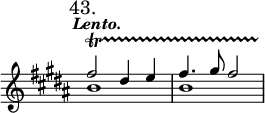the accent of the shake must be upon the upper note, that the note omitted may be a subsidiary and not a principal note. [App. p.792 "it should be mentioned that Von Bülow, in his edition of Cramer's studies, interprets this passage in a precisely opposite sense to that given in the Dictionary, directing the shake to be performed as in example 44 of the article."]
Cramer, Study. No. 11.


Beethoven, Sonata, Op. 109.

![{ \new Staff << \tempo \markup \italic "Played." \key e \major \time 3/4
\new Voice \relative b'' { \stemUp \tuplet 3/2 4 { b8 ais b b e, e } }
\new Voice \relative b'' { \stemDown b32*2/3 b, cis b ais'[ b, cis b] b' b, cis b b'[ b, cis b] e b cis b e[ b cis b] } >> }](http://upload.wikimedia.org/score/0/l/0lim2q6994gjeylgcvc0txm6mrab1k1/0lim2q69.png)
The above arrangement constitutes what is called a false trill, the effect of a complete trill being produced in spite of the occasional omission of one of the notes. There are also other kinds of false trills, intended to produce the effect of real ones, when the latter would be too difficult. Thus Ex. 45 represents a shake in thirds, Ex. 46 a shake in octaves, and Ex. 47 a three-part shake in sixths.
{{block center|
Mendelssohn, Concerto in D minor.

Liszt, Transcription of Mendelssohn's 'Wedding March.'

Müller, Caprice Op. 29, No. 2.
![{ \new Staff << \mark "47." \time 4/4
\new Voice \relative a' { \stemUp \repeat unfold 2 {
s32 <a fis c>[ s q s q s q] } \bar "|" \partial 4 s4 }
\new Voice \relative d' { \stemDown
<d g b>32[ s q s q s q] s q[ s q s q s <b d g>] s q8 r } >> }](http://upload.wikimedia.org/score/9/v/9v37blkyq4rwvpazqk71vy4tznyi8au/9v37blky.png)
The above method of producing a shake in three parts is generally resorted to when great force is required, otherwise the ordinary method is quite practicable, and both double and triple shakes are frequently met with in modern brilliant music (Ex. 48, 49).
Chopin, Polonaise, Op. 25.

Beethoven, Polonaise. Op. 89.

The speed of a shake cannot be exactly defined in notes, since it is usually better, except in the case of very short trills (as in Ex. 29), that the notes of the shake should bear no definite proportion to the value of the written note. Generally, the shake should be as rapid as is consistent with distinctness. When a proportional shake is required it is usually written out in full, as at the end of the Adagio of Beethoven's Sonata in E♭, Op. 27, No. 1.
SHAKESPEARE, William, composer, vocalist, pianist, born at Croydon June 16, 1849. At the age of 13 he was appointed organist at the church where formerly he had attracted attention in the choir. In 1862 he commenced a three years course of study of harmony and counterpoint under Molique; but after that master's death, having in 1866 gained the King's Scholarship at the Royal Academy of Music, continued his studies there for five years under Sir W. Sterndale Bennett. Whilst at the Royal Academy he produced and performed at the students' concerts a pianoforte sonata, a pianoforte trio, a capricio for pianoforte and orchestra, and a pianoforte concerto; and attracted some notice as a solo-player.
He was elected Mendelssohn Scholar in 1871, for composition and pianoforte-playing, and in accordance with the wish of the Committee entered the Conservatorium at Leipzig. There, whilst under the instruction of the director, Carl Reinecke, he produced and conducted in the Gewandhaus a symphony in C minor. Having discovered himself to be the possessor of a tenor voice, he was sent by the Mendelssohn Scholarship Committee to study singing with Lamperti at Milan, and there remained for two and a half years. But though singing was his chief pursuit he did not neglect composition, and while in Italy wrote two overtures, two string quartets, and other works.
In 1875 he returned to England, and entered upon the career of a concert and oratorio singer. He was appointed in 1878 Professor of Singing, and in 1880 conductor of the concerts, at theRoyal Academy of Music.
